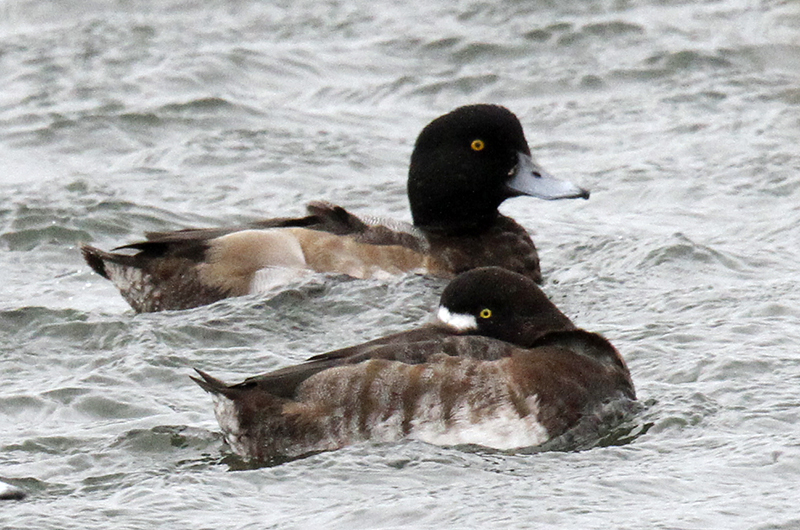Christmas Bird Count. We lucked out — sort of — this year. My recollection of most of the recent counts is that they have been held in rainy weather, which is not the best for finding birds. We had light rain this year but only for the first hour or so of daylight. And the fog rolled in for part of the afternoon; it is hard to find birds when one can see less than 100 yards.
Foggy weather can tease you. Olsen Houghton reports that at the end of an extremely foggy day, his Seven Gates team finally got to see the Elizabeth Islands for the first time. He says, “We raced to our cars to get to the overlook to scan Middle Ground for seabirds. We arrived at the overlook in under five minutes but the entire area was again covered in fog with zero visibility. The best bird sighted was a kingfisher." That was first heard from within the fog bank before it was spotted flying across the pond.
Overall, the count went well. Preliminary totals are 19,722 individuals consisting of 120 different species. These numbers make for an average year for the number of species for the past decade, and slightly above average for the numbers of birds counted. The numbers will change somewhat as compiler Luanne Johnson reviews the results.
Most notable has to be the addition of two species never before seen on a Vineyard Christmas Bird Count: western tanager and blue-headed vireo. Allan Keith has been seeing the tanager regularly since Nov. 18, always in the same thicket near Squibnocket Pond. The species is a vagrant from the western part of America but seems to be coming east more frequently. The vireo is a regular fall transient that has been staying later with each passing year. Likely global weirdness — also known as climate change — can account for the warmer late fall and early winter temperatures, enabling these species to survive while staying further north and east.
We also set new high counts for two species: greater scaup and tree swallow. We counted 1,889 greater scaup this year, slightly besting the high count of 1,806 recorded in 1989. This species was found by eight of the 13 field teams but slightly more than three fourths of these diving ducks were seen in Tisbury Great Pond and on Chappaquiddick. An incredibly large flock of 865 scaup (yes, I counted each one!) was observed covering the great pond from Deep Bottom Cove to the Quansoo shoreline.
We observed 94 tree swallows this year on the count. While they have been seen on about half of the counts since 2000, we usually see less than 10 of them. The previous high was 80 swallows reported in the 1995 count. My Long Point team saw a flock of 60 as they flew across Long Point, briefly below the fog about 100 feet above our heads. Again: the warming temperatures are allowing this common breeding species to stay further north later into the year.
American robins came close to setting a new high this year. We observed 2,206. The high count of 2,590 robins was recorded in 1998. All the field teams found some but Tisbury Meadow hosted about three fourths of these birds (1,590 individuals) at the very end of the day. Matt Pelikan: says, “They must have been birds from the Cape arriving as they moved south. They were passing overhead in groups ranging from a few individuals to several hundred coming out of Vineyard Haven at a fairly high altitude and descending as they crossed Tisbury Meadow. Many landed in the trees on the southwest side of the meadow, occasionally taking off and ripping around for a couple of minutes in a big murmuration. An impressive phenomenon!” The robins were still arriving as it was getting too dark to see them.
Pine warblers also set a new high this year, with 31 birds sighted. That does not sound like a lot of birds but until 2018 we seldom saw more than five individuals. In 2018, we spotted 15 and in 2020 we found 26. Nineteen were found this year in two territories: Lambert’s Cove and Seven Gates. The seven warblers from the Lambert’s Cove team were in one flock, along with a palm warbler. The bright yellow in a tree initially caught their eyes but then the birds flew down to the unmowed field and foraged there for a while, a behavior more typical of the palm warbler that was with this flock.
Ken Magnuson was out in the rain at 4 a.m., looking for owls at Wilson’s Landing in Edgartown. He got an unexpected response to his playing of a screech owl recording (we play the recording judiciously as it changes a bird’s behavior): a long-eared owl started calling! This is only the third time this owl has been found on a count since 2000.
The mainland Edgartown field team also recorded common merganser, brown thrasher, and an orange-crowned warbler. A second orange-crowned warbler was spotted by Steve Carey’s Quansoo team.
Luanne Johnson reports that her Oak Bluffs team was pleased to find both a northern shoveler — a duck with a huge shovel-like beak — and a gadwall on Crystal Lake.
Tony Lima’s Chappaquiddick beaches team got lucky with the fog. They were able to spot four razorbills and three dovekies.
Chris Murphy and Warren Woessner’s North Road team was pleased to find a yellow-bellied sapsucker in plain view just 20 feet in front of them. That may not sound noteworthy but this woodpecker is a specialist at hiding, often keeping a tree trunk or a branch between us and them.
Please email your sightings to birds@mvgazette.com.
Robert Culbert is an ecological consultant with Nature Watch LLC living in Vineyard Haven.








Comments
Comment policy »